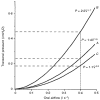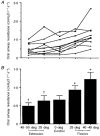Oral airway flow dynamics in healthy humans
- PMID: 9925899
- PMCID: PMC2269117
- DOI: 10.1111/j.1469-7793.1999.293ad.x
Oral airway flow dynamics in healthy humans
Abstract
1. Oral airway resistance (RO) is an important determinant of oro-nasal partitioning of airflow (e.g. during exercise and sleep); however, little is known of factors influencing its magnitude and measurement. 2. We developed a non-invasive standardized technique for measuring RO (based on a modification of posterior rhinomanometry) and examined inspiratory RO in 17 healthy male subjects (age, 36 +/- 2 years (mean +/- s.e.m.); height, 177 +/- 2 cm; weight, 83 +/- 3 kg). 3. Inspiratory RO (at 0.4 l s-1) was 0.86 +/- 0.23 cmH2O l-1 s-1 during resting mouthpiece breathing in the upright posture. RO was unaffected by assumption of the supine posture, tended to decrease with head and neck extension and increased to 1.22 +/- 0.19 cmH2O l-1 s-1 (n = 10 subjects, P < 0.01) with 40-45 deg of head and neck flexion. When breathing via a mouth-mask RO was 2.98 +/- 0.42 cmH2O l-1 s-1 (n = 7) and not significantly different from nasal airway resistance. 4. Thus, in awake healthy male subjects with constant jaw position, RO is unaffected by body posture but increases with modest degrees of head and neck flexion. This influence on upper airway patency may be important when oral route breathing is associated with alterations in head and neck position, e.g. during sleep.
Figures



References
-
- Anch AM, Remmers JE, Bunce H., III Supraglottic airway resistance in normal subjects and patients with occlusive sleep apnea. Journal of Applied Physiology. 1982;53:1158–1163. 10.1063/1.329867. - DOI - PubMed
-
- Camner P, Bakke B. Nose or mouth breathing? Environmental Research. 1980;21:394–398. - PubMed
-
- Cole P. Nasal airflow resistance. In: Mathew OP, Sant'Ambrogio G, editors. Respiratory Function of the Upper Airway. New York: Dekker; 1988. pp. 391–414.
-
- Cole P. Nasal and oral airflow resistors. Site, function and assessment. Archives of Otolaryngology Head and Neck Surgery. 1992;118:790–793. - PubMed
-
- Cole P, Forsyth R, Haight JSJ. Respiratory resistance of the oral airway. American Review of Respiratory Disease. 1982;125:363–365. - PubMed
Publication types
MeSH terms
LinkOut - more resources
Full Text Sources
Research Materials

